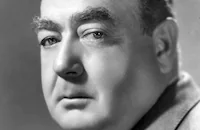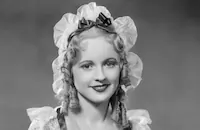This breezy pre-code drama, perfectly suited for the palate of a Depression-era audience, was bolstered by its roster of talents. Directed by George Cukor, Girls About Town stars Kay Francis, Joel McCrea, Lilyan Tashman and Eugene Pallette. Francis and Tashman play escorts who work diligently to drain the coffers of their wealthy clientele. McCrea and Pallette are the gold-diggers’ latest targets. The story evolves from comedy to drama as McCrea’s and Francis’ characters enter a high-stakes romance.
Cukor was only in his second year as a film director. He brought his expertise as a theatrical director to Paramount where he served as a dialogue coach and assistant director. Cukor quickly rose in ranks at the studio with his know-how and his connections. Part of his social set included writer Zoe Akins, best known for theatrical plays, including “The Furies,” which Cukor had directed on Broadway. She was no stranger to the film industry and was a frequent collaborator of Dorothy Arzner.
For Girls About Town, Akins took inspiration from her play “The Greeks Had a Word for It,” another gold-digger story, to come up with an original treatment for this project. Akins wrote the characters of Wanda and Marie with Tallulah Bankhead and Lilyan Tashman in mind. However, Kay Francis, who like Bankhead and Tashman was the life of many an extravagant New York party, was cast instead. Akins’ story was adapted for the screen by Raymond Griffith, who also served as producer, and Brian Marlow.
By 1931, Kay Francis was on the eve of stardom. She had 20 films under her belt but was still shy of developing her reputation as Hollywood’s best-dressed woman and “The Queen of Warner Bros.” She made Girls About Town just before her contract with Paramount expired. Francis and her co-star Tashman were decked out in a stunning wardrobe designed by Travis Banton that included fur coats, stylish party wear and silky lingerie. Tashman was quite familiar with high-class style. She became known for her acting, fashion sense and her social life. Having started in vaudeville, she performed in the Ziegfeld Follies and made the transition to film in 1921. She successfully made the jump from silents to talkies and by 1931 had close to 60 films on her resume and had signed a contract with Paramount to make nine more.
Another Hollywood lifer was character actor Eugene Pallette, who started in films in 1915. He became known for his distinctive “froggy” voice and stout build. Other cast members include Anderson Lawler, cast by his close friend George Cukor, who soon became Kay Francis’ regular escort for events. Louise Beavers plays Hattie, the maid-turned-partner-in-crime for the two female protagonists. Beavers had previously worked for Tashman as her personal maid. In one scene, Beavers poses as “Whistler’s Mother,” a painting that would have been well-known to an early 1930s audience and in a few years would be featured on a US stamp. For party scenes, new Paramount contractees Adrienne Ames, Claire Dodd, Judith Wood and Cecil B. DeMille’s daughter Katherine DeMille were cast. Lucile Gleason, wife of James Gleason, also has a small role.
Joel McCrea was the final addition to the cast. Originally Paul Lukas was set to star, and early Paramount marketing materials for the film include his name. When he eventually dropped out, RKO loaned McCrea out to Paramount. It’s very likely that McCrea was cast because of his good looks, and his height (6’2”) would have complemented Kay Francis who was 5’9”.
Production for Girls About Town began in August 1931. According to Film Daily, Paramount created a mobile “interior motion picture setting for emergency use outdoors” while Cukor and his team were filming the yacht scenes on Catalina Island.
According to Francis biographers Lynn Kear and John Rossman, the Hays Office warned the studio about the excessive use of lingerie as well as “the implication that [Francis] would not mind being [McCrea’s] mistress.” It’s unclear if any changes were made.
Girls About Town premiered November 7, 1931. The marketing team at Paramount pushed the film as a crowd pleaser sure to earn box office gains for the theaters that showed it. Publicity materials boasted “Glorious Romance. Uproarious Comedy. Beautiful Girls Gorgeous Gowns. Sparkling Wisecracks.” The film received mixed reviews from critics. Mordaunt Hall of The New York Times wrote, “This handsomely staged and ably directed production is one that affords no little laughter, but unfortunately it is burdened in the latter stages by highly improbable serious sequences.” In Louella Parsons’ review for the Los Angeles Examiner, she wrote, “If I had had the scissors I would have trimmed the picture and kept only the fast moving comedy.”




























